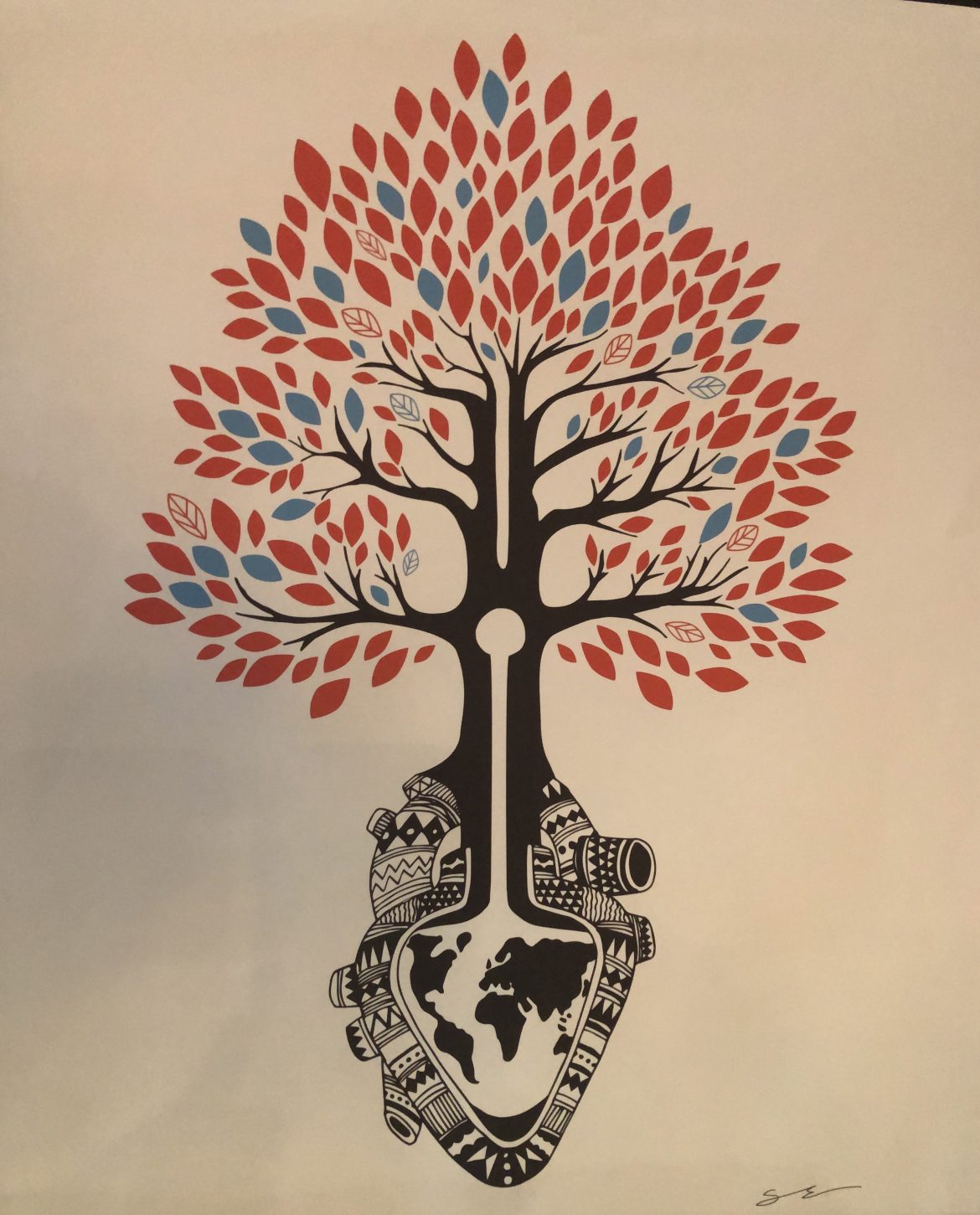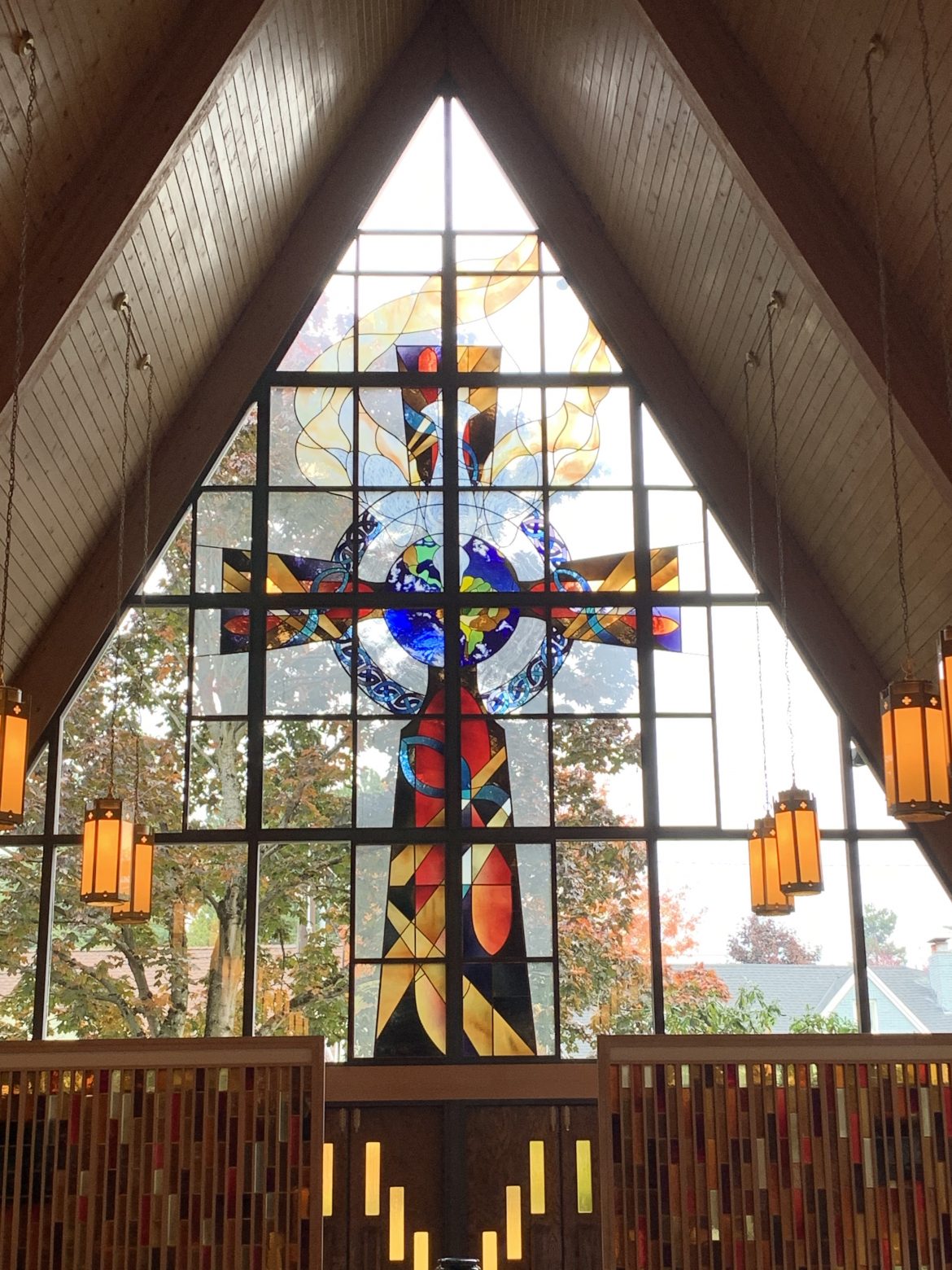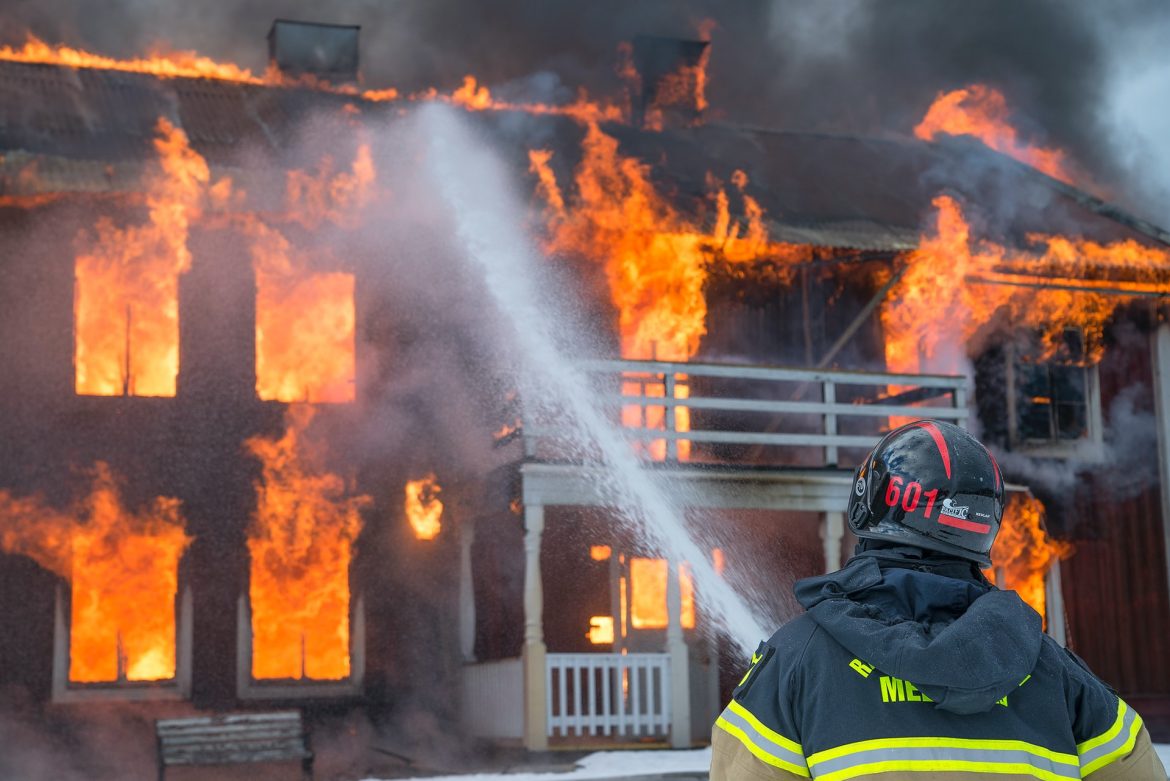by Lilly Lewin
As a visual learner, God has used Art to speak to me most of my life. In recent years, I have made looking at art and going to art museums more of a prayer practice. Art is now a regular part of my spiritual life, both praying with art and creating art as a prayer practice. One artist who is often a part of my daily prayers is Scott Erickson. He is a spiritual director as well as an amazing artist, and he’s my friend. Almost daily on Instagram, Scott (@scottthepainter) posts one of his wonderful images to pray with and he posts beautiful words to reflect on with the image. Scott’s work has helped me grow closer to Jesus. The Lord has used his images to help me know that He is taking care of me and knows my heart. Scott’s work below is called “Be Not Afraid” and it’s been on my wall as a reminder all through this season of the pandemic.
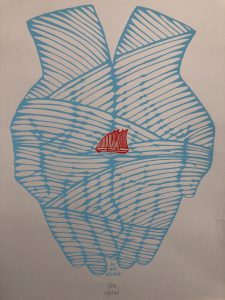
BeNotAfraid Scott Erickson
There is a fancy word for using art as a prayer practice. It’s called Viso Divina.
Visio Divina is the practice of looking at a painting, a photograph, or even a movie, and allowing the Holy Spirit to speak to you through the Art. The video below is a directed Visio Divina I created for you and your friends, family to Pray with Art. I was inspired by Scott’s piece called “Flourishing Heart” to consider all the things God is doing in us and through us in our neighborhoods and cities. The Holy Spirit is already at work, we just need eyes to see and ears to hear.
What is the Holy Spirit growing in you? In your neighborhood, are you willing to open the door, open your heart and be a part of it? This is especially needed for those of us here in the States as we approach November 4th and the Election. We need to watch for what the Holy Spirit is up to and be planters of peace in our neighborhoods.
WATCH and PRAY with ART
And for further inspiration, check out Scott’s work on Instagram: @scottthepainter and his website. He has many beautiful images for you to pray with and for you to frame for your home! And check out his new book coming out for Advent, called “Honest Advent”! It launches on October 20th! SO EXCITED!
I’ve had a sneak peak, and it’s a beautiful way to pray through the season focusing us on the birth of the baby, and Emanuel, God with us, entering the messiness of our life. I highly recommend it! Scott even has bonus gifts for preorders and for churches too.
ACTION: Watch the video and pray with me with Scott’s Art. Take some time to pray in other ways with ART this weekend! Get out your crayons or markers and just doodle! Read the 23rd Psalm and create from it! Allow the Holy Spirit to inspire you! Go to a Museum or Gallery if you are able, or take a virtual tour (National Gallery in London) and ask the Holy Spirit to inspire you and speak to you through the art.
I would love to hear what Art inspires you and hear what you think about the video practice too. And if you’d like more information or help with putting art into your worship gatherings, just ask!
by Lisa DeRosa
Today, October 1st, is World Vegetarian Day. While I cannot claim to be vegetarian myself, I tend to cook more vegetarian dishes than meat-based dishes at home on a regular basis. There are a few reasons why this is the case. Since I still consider myself to be newly married (3.5 years counts, right?!), and with our budget being on the tighter side, I try to be frugal with the 20-21 meals we are eating at home each week. To be honest, it’s challenging! But I am blessed that my husband loves vegetables and is not a picky eater; he would be content to eat the same thing for breakfast, lunch, or dinner for several weeks in a row. I am NOT like that. I need variety! Excitement! A change in flavor about every three days… So you can imagine the difficulty I place on myself when meal planning. The key that I have found to livening up vegetables is the seasoning. We make a blend of spices that we use on basically everything from tacos, grilled veggies, eggs and potatoes… you name it. Having a few of your favorite spices on hand can make all the difference.

Potato tower, photo by Lisa DeRosa
Because of the amazing garden around us, it doesn’t take much to be truly inspired from the vegetables and fruits grown right outside. I am very new to gardening but can attest to the wonderful teacher and gardener that Christine is! This year at the Mustard Seed House, we are experiencing a plethora of delicious garden produce! The tomatoes, squash, beans, potatoes, garlic, onions, kale, and the list goes on, have been a huge blessing to us and our household. God has provided a bountiful harvest in the midst of a truly hectic year. My level of gratitude for an heirloom tomato, fresh off the plant, has soared. It has taken almost two years, but I can recognize what plant the sprouts in the garden will grow into without a label! I even helped my housemate build the potato tower to grow the potatoes in this year and each potato tastes better than anything I could purchase from a store! Putting together meals with these fresh ingredients coaxes me to make tasty plant-based food.
These days, the research is out there about how over-consumption of meat is harmful to our bodies, the environment, and, obviously, the animal that is killed to provide the meat. So in the heart of choosing self-care and care for creation, would you consider eating one meal today that does not contain meat? Could you challenge yourself further to go all day without meat? (Please make sure you incorporate plant proteins like beans, lentils, nuts, or soy throughout your day!) If you need some ideas for recipes, check out some of my favorites that Christine provides below:
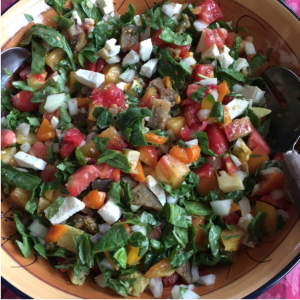
photo by Christine Sine
- Tomato, basil, eggplant and mozzarella cheese salad
- Curried Pumpkin and Black Bean Soup
- Walk Through the Garden Soup
- Cooking with Quinoa
- Other recipes on the Hospitality page
Check out this video about a 100% vegetarian market in Vancouver. My mouth is watering just watching!
Photo of produce above: © Christine Sine.
I’m going to tell you a little secret,
a little hard-learned truth,
gained upon through long labour,
and an endless broken walk.
I’m going to tell you a whisper,
a revelation to the heart,
of an ease you cannot discover
but for the pain of the path.
Do not torture yourself.
We don’t come to ourselves
through failed works, but
through a kindness that turns in on itself.
There is no more proof required.
We are – in our shambling states –
circling for higher footholds –
enough,
right here in the midst of ourselves.
There, in our earnest quest for
betterment, for earning mercy,
is a place we had from the start,
deep inside, marked for rest.
It never disappeared,
we were always worthy of it –
just didn’t know of it,
without the winding road
ahead, behind.
Ana Lisa de Jong
Living Tree Poetry
May 2020
You have burrowed deep into Me, child, into My peace. Deep, deep, deeper still to go. I lead you on always into even greater peace. Peace in any and every situation. Undisturbed, untroubled, well-being. That is where I want you to live your life, deep in the peace with Me.
“And He said to her, Daughter, your faith has made you well! Go (enter) into peace (untroubled, undisturbed, well-being).”
Luke 8:48~ Pamela Steinke
In Duality, there is choice and exclusion. In Trinity, there is balance, flow, and harmony.
Duality is the realm of fallen mankind. Trinity is the realm of our spiritual revival, renewal, and restoration in Our Father, Son, and Holy Spirit. All spirituality is incarnational, transforming us from the inside out and from the bottom up.~ Bob Holmes
For more poems for Ana Lisa de Jong, check out the free downloads available in our store:
How do you see St Michael? One of God’s mighty angels? Or, in the UK, a clothing brand by a large department store? [Marks and Spencer’s St Michael’s range] Or as he is depicted in many paintings and church stain-glass windows, the white superhero spearing the brown devil?
Michael, the archangel, Saint Michael, appears all over the place. He’s not just in the Hebrew and Christian Bible, but also in the Quran and in neo-pagan literature, as well as in countless poems, paintings, statues, music and jewellery. But wherever he appears, he is always strong and invincible.
In the Book of Daniel Michael, the archangel, appears to Daniel and says he is “the protector of Israel” (Daniel 10:13-21) and in Daniel 12:1 saying he will “arise again during the end of time”. In both the Book of Jude (1:9) and in the Book of Revelation (12:7-9), the Archangel Michael is stronger than Satan and defeats and banishes him. In the Quran Sura 2:98 says “Whoever is an enemy to God, and His angels and His messengers, and Jibrail and Mikhail! Then, God (Himself) is an enemy to the disbelievers.” Some Muslims believe that Michael is one of the three angels who visit Abraham (Sura 11:69).
Neo-pagan tradition has leylines, lines of spiritual energy that pass through various points on the land. The most famous one is the St Michael’s leyline; which goes from St Michael’s Mont in Cornwall, through Glastonbury Tor to Bury St Edmunds, Norfolk. There is another St Michael’s leyline from Skelling Michael, Ireland, through St Michael’s Mont, Cornwall to Mount Carmel in Israel.
In Alexander Carmichael’s The Carmina Gadelica, compiled during his travels as in the Scottish Highlands and Islands during the late nineteenth century, 29th September, the Feast of St Michael, was a time for great celebration; with feasting, dancing, visiting the ancestral graves, horse racing, and young people to find a partner. Ray Simpson says in Exploring Celtic Spirituality, every husbandman would give food to the alms-deserving as an offering to “the great God of the elements who gave him cattle and sheep, bread and corn, power and peace, growth and prosperity, that it may be for his abject, contrite soul when it goes thither”. Saint Michael’s feast day was seen as a day of promise to the young and a day of fulfillment for those older, and a day of retrospection to the aged. Carmichael says, “it is a day when pagan cult and Christian doctrine meet and mingle like the lights and shadows on their Highland hills.”
Around the same time Carmichael was gathering his The Carmina Gadelica, the Catholic church in Rome was under persecution from the King of Italy, and the pope wrote this prayer to St Michael.
St Michael’s prayer
“Saint Michael the Archangel, defend us in battle. Be our protection against the wickedness and snares of the devil; May God rebuke him, we humbly pray; And do thou, O Prince of the Heavenly Host, by the power of God, thrust into hell Satan and all evil spirits who wander through the world for the ruin of souls. Amen.”
So again I ask, how do you see St Michael? End time deliverer, patron saint of the harvest, the defeater of the devil, a great redeemer, a connector of power lines through the earth? Which one of these Saint Michaels do you want him to be? Or maybe, in these turbulent times, we need him to be all of these – to help us take joy in what we have reaped and what will fulfill us during these times (harvest), defeater of the devil/our enemies, one who can redeem the earth to its purpose, and able to connect the power of the earth to help redeem us from global warming, pandemics, etc.
These are times of great trial, times when we need to look above and beyond, times when we need all the help God has, but also time to rejoice in the good of what is being harvested. Perhaps we do need to stop and reflect and see this day as a day of promise to the young. A day of fulfillment for those older, and a day of retrospect to the aged. Let us pray the prayer but also rejoice and remember that St Michael, and God, are all these things.
REFERENCES:
“Celtic Christian Spirituality: An Anthology of Medieval and Modern Sources” by Oliver Davies and Fiona Bowie for the quotes from Alexander Carmichael’s The Carmina Gadelica
“Exploring Celtic Spirituality” by Ray Simpson
Photo by Guido Reni – http://www.andrewgrahamdixon.com/archive/readArticle/257, Public Domain, https://commons.wikimedia.org/w/index.php?curid=9571452
by Christine Sine
Tom and I have just returned from a very wet neighbourhood walk – such a contrast from a week ago when the dry smoke-filled air carried toxic chemicals and was hazardous to breathe. It is so good to breathe fresh air again and be able to enjoy our beautiful neighbourhood walks. I have found myself gasping in awe at the patterns of raindrops on flowers, leaves and even spiderwebs. The rain has invigorated me, and, not surprisingly, had me searching for my post on rain walking from last year where I talked about how good rain is for us in body, mind and spirit.
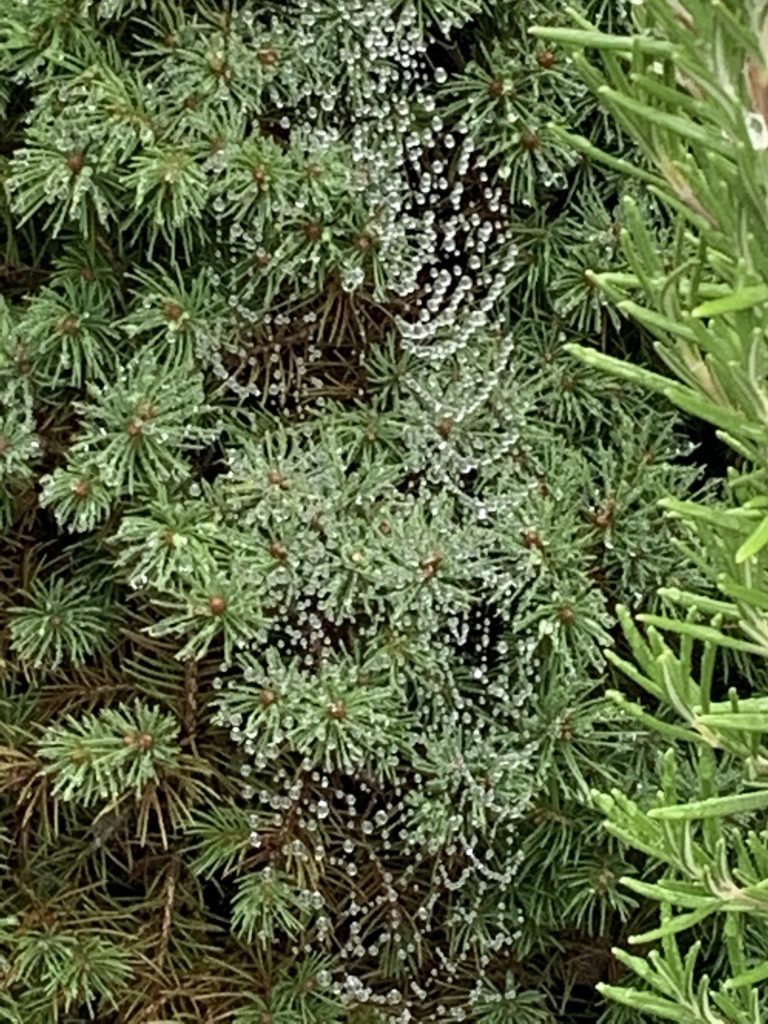
Raindrops on spiderwebs.
This year, however, my daily rain walks have made me hyper aware of those who still cannot breathe. Here in Seattle, the wildfires in California, Oregon and Washington State left us with toxic air for over a week. In other places, it continues and may do so for weeks if not months. Then there are those who never have the opportunity to breathe clean air because they live and work in polluted environments – farm workers who use toxic pesticides, poor communities around the world that are built near industrial complexes that spew forth environmental pollutants of all kinds. Many of these people provide the rest of us with consumer products we don’t really need.
From there, my thoughts shifted to other things that restrict our ability to breathe. That is the theme for this year I realize. – I CAN’T BREATHE – because of virulent diseases that congest our lungs, because of injustice that throttle our throats and because of pollution that clogs our air. Some of us can’t breathe because of the tears that constrict our throats as we ache for those who are live without the privileges we enjoy. As I thought about this the following prayer came to me:
O God,
who breathed
and gave us life,
Give us breath once more.
May all your creation be able to breathe,
Without virus to congest our lungs,
Without injustice to throttle our throats,
Without pollution to clog our air.
Restore our breath, O God.
Replace exhaustion with joy and enthusiasm.
Renew our spirits.
May we all work to enable all persons and all creatures
to breathe freely,
Of the One who gifts us with the breath of life.
I find the rain is teaching me a lot of lessons this week. As it washes away the toxins in the air and turns my despondency into joy, I also notice that it is turning my exhaustion into renewed energy and enthusiasm. I wonder what “rain” do we need to turn our exhaustion at more COVID deaths, more reports of injustice and the constant knowledge of environmental pollution into joy and enthusiasm? Perhaps it is a time of retreat away from the news and our usual daily routines. This is a popular theme of mine. Retreats are powerful tools and as Tom and I get ready for our own retreat, I encourage you to do the same.
This year, we are taking an “at home retreat” and like us, you may not be able to go away but that does not stop you from taking time for retreat. Plan a time to turn off your phone, your social media, your internet access. Quieten the house as much as possible. As I suggest in my previous post on retreats, do some scripture reading and reflection, do some journalling, and intersperse these times with walks or creative exercises that stir the right side of your brain.
This is not a time to give up or give in to exhaustion. This is a time to “walk in the rain” as it were, wash away the toxins that are restricting our breathing and refresh ourselves in order to engage the challenges that will continue to confront us.
Another beautiful contemplative service from St Andrews Episcopal church in Seattle. Find a quiet place. Light some candles and enjoy.
Carrie Grace Littauer, prayer leader, and music by Kester Limner and Andy Myers.
Permission to web stream or podcast music in this service is granted under One License number A-710-756.
by Tom Sine, article by Cayla Clark
As I posted about this last April, Morgan Schmidt, a pastor in a Presbyterian Church in Bend, Oregon introduced the creative invention of Pandemic Partners. People in churches started using their Facebook group to learn which of their neighbors needed help in this very disruptive time and responded.
The recent destructive wildfires in Oregon and California again ignited the creativity of Christians in Oregon. They have recently created Central Oregon Dine 11 to feed wildfire evacuees while supporting local restaurants.
“As the smoke clears and locals slowly return to their (COVID-era) day-to-day lives, many Central Oregonians remain displaced, distressed and without homes to return to—their lives upturned for the foreseeable future.
As a record-breaking 900,000 acres of Oregon land continued to burn this week, upward of 500,000 people remained under some form of evacuation order.
From the moment news of the fires spread, local business owners banded together to take action. Despite the fact that local restaurants have taken a major hit due to COVID-related restrictions, cafes and eateries like Bellatazza, Joolz, Nancy P’s and Terrebonne Depot joined together to serve breakfast, lunch, dinner and coffee.
‘As soon as we learned that people needed help, we set to work’, explained Stewart Fritchman, owner of downtown Bend coffee shop, Bellatazza. ‘As a local restaurant community, we all joined together. We all have kitchens, we all have skills, but all of our restaurants have been getting clobbered by COVID. So, by asking for donations and getting funds from the general community, we can get meals made and delivered to those in need.’
Bellatazza changed the home page of its website to become a donation page, where individuals could donate between $5 and $100 to go directly to fire refugees. ‘Donations could be in the form of gift cards; they could potentially go towards providing hot coffee to evacuees at First Presbyterian or providing hot coffee to those coming in from Detroit, coming in without a home. The local restaurant community has been putting together meals that are picked up by the Red Cross and taken to motels.’
What began as what Fritchman described as a ‘guerilla-style operation’ has developed into something more widely accessible. The newly created web page, Dine11 Central Oregon, is a central location where people can donate as much as they’d like to feed wildfire evacuees, while helping local restaurants stay afloat.
‘Dine11 is a nonprofit website hosted out of the Bay Area,’ explained Morgan Schmidt, founder of the Facebook group Pandemic Partners Bend, which was developed to help locals affected by COVID-19. ‘The website was started at the beginning of the pandemic to help support medical workers. Cheryl Howard, program manager, Events & Volunteer Program at City of Bend, suggested we look into it as a way of helping Central Oregonians who were affected by the wildfires. Everyone wants to help so badly, but there hasn’t been a central hub for people to do that. We want to be able to give to these folks in an organized fashion.’
The Central Oregon branch of Dine11 officially launched Friday. ‘This is a great way to support and feed evacuees while supporting local restaurants and essential workers,’ Schmidt said. ‘I hope this serves as a hub to feed folks who are hungry while supporting local businesses for a long time.’ People can donate at or sign up to volunteer. ‘We currently need volunteers to transport meals from local restaurants to evacuees in hotels or at the [Deschutes County] Fairgrounds,’ Schmidt concluded.
Fritchman added that the local restaurant community has developed another way to support local while feeding those in need.
‘We’re asking people to buy gift cards at their favorite restaurants, and then we’re taking these gift cards to the hotels where the evacuees are staying. The hotel manager will pick a gift card at random and hand it off to a family so that people can experience some sense of normalcy here in Bend; go out to eat, get a slice of pizza or go out for a cup of coffee. We’re waiting to get 105 gift cards, because that’s roughly how many evacuees we have staying in Bend. Cards can be dropped off at our downtown location.’”
What are innovative ways your church could create to make a real difference in the lives of your neighbors? We would love to share your stories.
——————————————————
Article published through Bend Source. For the full article: see “Giving Back in More Ways Than One” by Cayla Clark
As an Amazon Associate, I receive a small amount for purchases made through appropriate links.
Thank you for supporting Godspace in this way.
When referencing or quoting Godspace Light, please be sure to include the Author (Christine Sine unless otherwise noted), the Title of the article or resource, the Source link where appropriate, and ©Godspacelight.com. Thank you!

